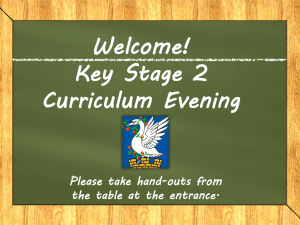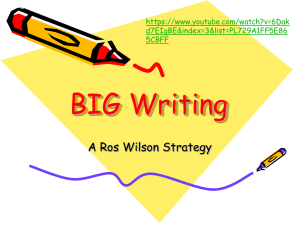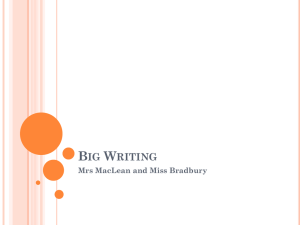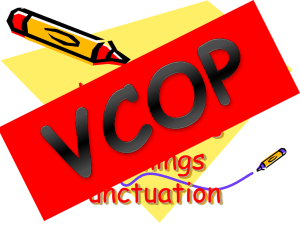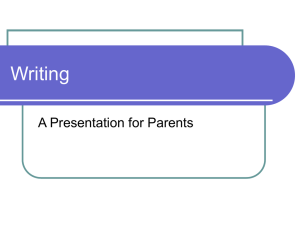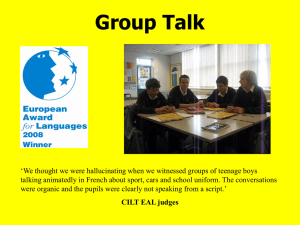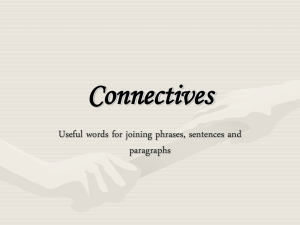VCOP adn Maths Intervention
advertisement
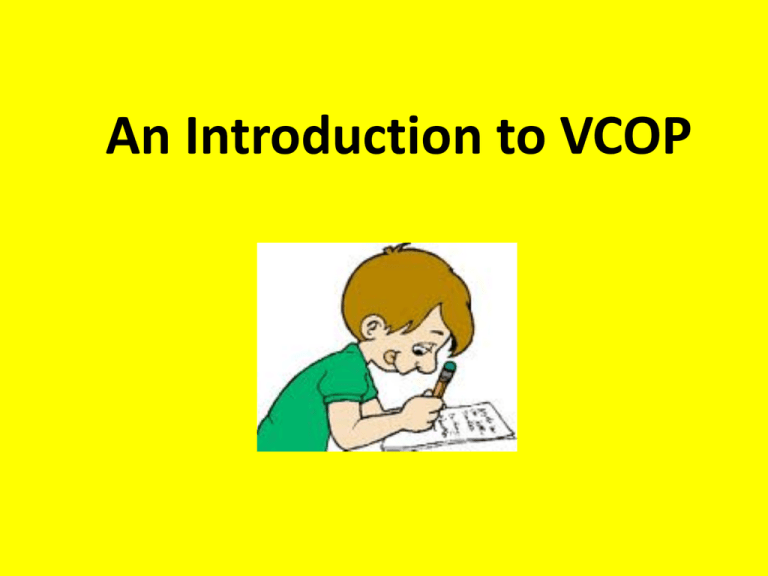
An Introduction to VCOP What does VCOP mean? Ros Wilson has spent 45 years working in Education in the UK. She realised that good writing consisted of 4 key components alongside accurate grammar, spelling and sense. V- Vocabulary C- Connectives O- Openers P- Punctuation VCOP sessions should take place daily for 5 minutes or so at the start of an English lesson. The sessions should be quite lively and focus on oral work as much as written. Soooo…what might a VCOP session look like? First, there would be a focus e.g. Connectives Connectives are words used to link together sentences. They can also act as ‘signposts’ between sentences and paragraphs to help the reader make sense of a piece of writing. Which connectives could you use between these pairs of sentences? It was raining. I went home. I felt overcome with relief. School had finished for the holidays. I have one brother. I have one sister. Kung Fu Punctuation Kung Fu Punctuation is a kinaesthetic way of teaching punctuation. It is a lively and fun activity that helps to reinforce different types of punctuation using funky moves. Good writing uses many different ways of opening sentences, for example: * Emergent Writers: I, Mum, Dad, The, He, She etc * Time connectives: First, After a while, Later etc * Subordinating connectives: Because, Although, However, Despite etc * Connectives to add information: As well as, Additionally, Furthermore etc * Adverbs: Quickly, I ran. Suddenly, a dog barked. * Verbs: Tired, Joe stumbled on wearily. Terrified, I leapt out of the window. Amongst the many other ways….! Providing sentence scaffolds to help children structure sentences using a variety of openers. As well as ______________, I also like ______________. Model an example for children to use as a scaffold then ask them to come up with their own ideas. Uplevelling sentences to include exciting vocabulary! This can be effective when pupils are able to work in pairs/groups and an element of competition is added e.g. Personal Points/smiley face/just being called ‘the winning group’! The boy went home . This is a terribly dull sentence. Can you work in pairs/groups to uplevel and improve it? (Thesauruses are always fab to have out as children will experiment with much more language. Even though it is often incorrectly used at first, this is part of the learning curve and they should be encouraged to experiment.) How could you support pupils during a VCOP session in class? • Working with individuals/groups • Scribing ideas as the teacher gathers them • Also, use the ideas during intervention sessions/ group work. Maths Interventions Sometimes pupils are not working at the level expected for their age group. Since the Learning Mentors have arrived, we have been able to begin implementing more intervention groups to try to close the gaps and accelerate the progress for those pupils. This year, we want to continue with this to target those pupils who have gaps in their leaning. What are the ‘levels’ pupils should be working at in each year group? By the end of Year 1, the age related expectation is a 1b/1a. By the end of Year 2, the age related expectation is a 2b. By the end of Year 3, the age related expectation is a 2a/3c. By the end of Year 4, the age related expectation is a 3b. By the end of Year 5, the age related expectation is a 3a/4c. By the end of Year 6, the age related expectation is a 4b. What does each level look like? On you table you will find some copies of documents called ‘Securing Level…’ These are saved on the system so can be printed at any time. Have a look through them to see what children would be expected to be able to do at each of the levels. These will be used to inform your planning for intervention groups. We have a range of interventions available for you to use to support pupils in your year group. All of them focus on Number skills and Problem Solving rather than Shape or Data Handling as without a secure understanding of numbers, they will not be able to do an awful lot with shape or data anyway! It also carries the most weighting in terms of the amount of teaching time and types of questions on assessments. What can we use to plan our intervention groups? Year 1: • Max’s Magic Maths • Securing Level 1 Year 2 • Securing Level 1 or 2 (or 3 for the G & T groups) • Wave 3 (for pupils working far below age related expectations who are expected to achieve Level 1 at the end of Year 2) Year 3 • Securing Level 1 or 2 or 3 • Springboard 3 (for pupils who are working slightly below age related expectations) • Wave 3 (as above) Year 4 • Securing Level 2 or 3 (or 4 for G & T groups) • Springboard 4 • Wave 3 • Overcoming Barriers Level 2-3 Year 5 • Securing Level 2 or 3 or 4 • Springboard 5 • Wave 3 • Overcoming Barriers Level 2-3 Year 6 • Securing Levels 3 or 4 (or 5 for G & T groups) • Springboard 6 • Wave 3 • Year 6 Booster Lessons But where are all these amazing resources? I hear you cry…. As all the UK Government resources were archived, the best place to find resources is: http://www.ness.uk.com/maths/intervention-materials.htm http://www.wirralmbc.gov.uk/VLE_Live_Resources/resources/level_2_3/index.html And on the system at… British Curriculum- Subject Leaders- Maths 2011-2012- What Can I do and Securing Levels Calculations in SRS Here at SRS, we have a clear calculations policy that is taught throughout the school. When you are working with groups or individuals, please ensure you are teaching the methods that the children are being taught, regardless of how bonkers it might seem compared to when you were at school!! Current practise has a much greater focus on both mental strategies and understanding calculations rather than rote learning a method.
